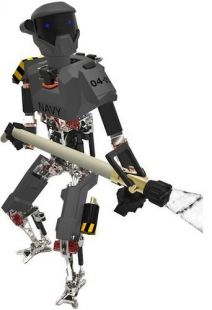The US military's first humanoid robot is going to fight fires and not engage in firefights

Welcome, SAFFIR. That's a humanoid robot the US Navy said will replace human firefighters onboard Navy ships.
SAFFIR stands for Shipboard Autonomous Firefighting Robot. Prototypes have been built by scientists at Virginia Tech, the University of California, Los Angeles and the University of Pennsylvania.
The robots already have some autonomy and can make decisions about taking steps and moving their joints. A human, however, will still supervise the robot; control the humanoid from a safe distance and decide on whether the robot is ready for its next task.
The Navy will test two different versions of the SAFFIR. One is a 5-foot-tall humanoid with a basic set of legs and a simple control mechanism. The other is a 6-foot-tall humanoid with more advanced legs that should be capable of better movement.
The tests will see the robots balancing on a boat, finding, picking-up and dragging a fire hose and then training the hose on a fire. The robots will use their vision systems to track the fire and search for victims.
The demo also will also test new sensors that have been designed to see through smoke. The robots also will have stereo, infrared and laser scanning sensors. The U.S. Navy's Office of Naval Research will conduct the tests of the robotic firefighters this summer.
"People can only stand relatively short periods of time directly fighting the fire because of the heat, the radiation, the smoke and the steam," said Thomas McKenna, program officer in the Office of Naval Research's Warfighter Performance Department in the Human-Robot Interaction Division.
"A firefighter during a shipboard fire may only be able to be exposed for 15 minutes. The idea is to get around those human limitations."